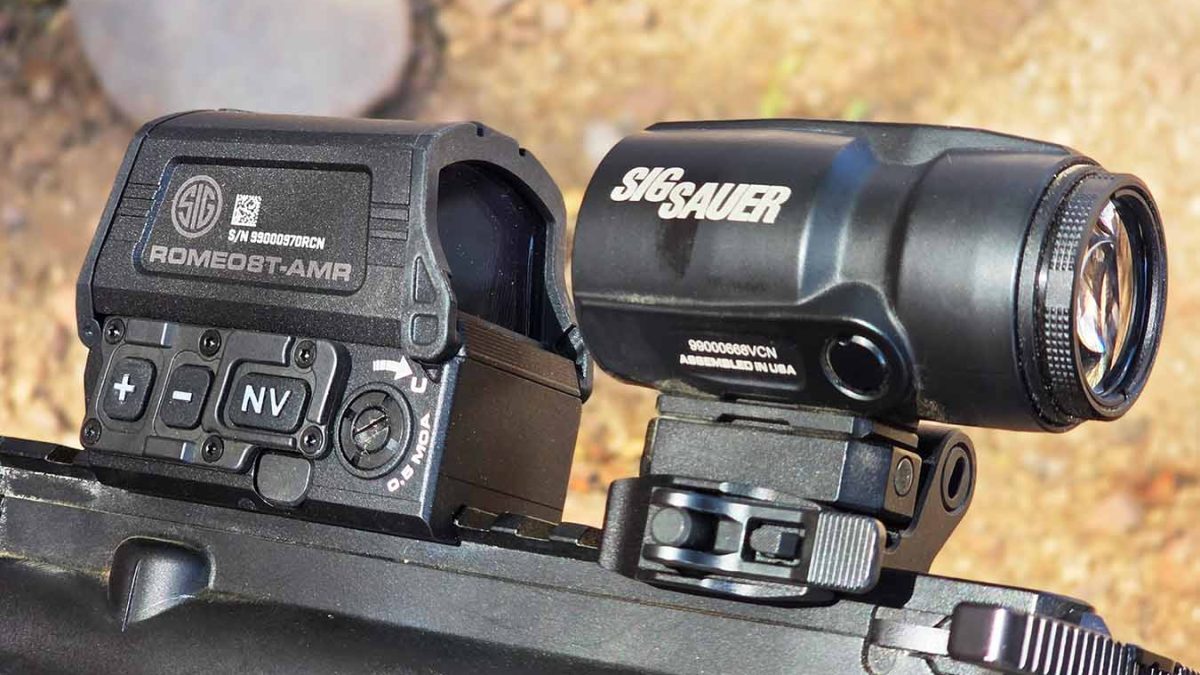It’s been a while since we saw any innovation in the rifle world, but something that keeps pushing the bounds of what is possible is the world of optics. One neglected segment of that is the red dot + magnifier combo. SIG Sauer’s Automatic Modified Reticle (AMR) changes that in a huge way.
SPECS & FEATURES
- Waterproofing: IPX-8
- Height: 62.9 mm
- Magnification: 1X / 3X
- Clear Aperture: 20 mm
- Overall Length : 6.1 in
- Overall Width: 2.7 in
- Battery : (1) CR123
- Reticle: Quad Ballistic Circle Dot 2.0 Automatic Modified Reticle
- Weight: 19.2 oz
- Illumination Settings: 15 (12 DT + 3 NV)
- Run Time: 50,000 hr
- Sight Height: 1.41 in (Absolute Co-Witness with Iron Sights)
- AMR – Automatic Modified Reticle
- MIL-810-STD Durability
- Assembled in Oregon, USA
PROS:
- Instantly switch from close-range settings to long-range settings
- Absolute game-changer for red dot + magnifier combo setups
- Highly durable
CONS:
- Only available for the Romeo8T
IN HAND & IN THE FIELD
In the war between LPVOs and red dot + magnifiers, my rifles almost always rock the dot and mag. From training classes to Brutality matches to 2-Gun, and more — the red dot and mag combo just works best for me and my applications.
Having used the AMR for several of these events, it’s hard not to feel like my other red dot and magnifier combos are now obsolete.
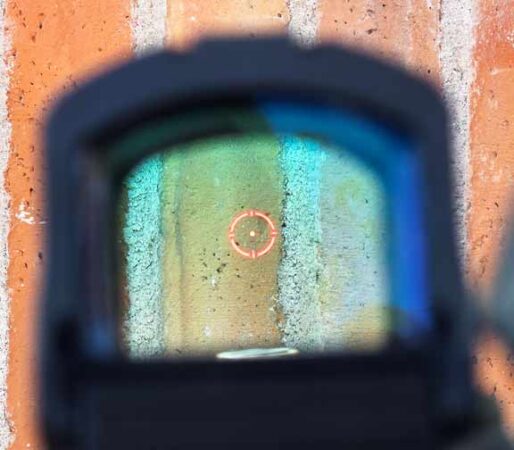
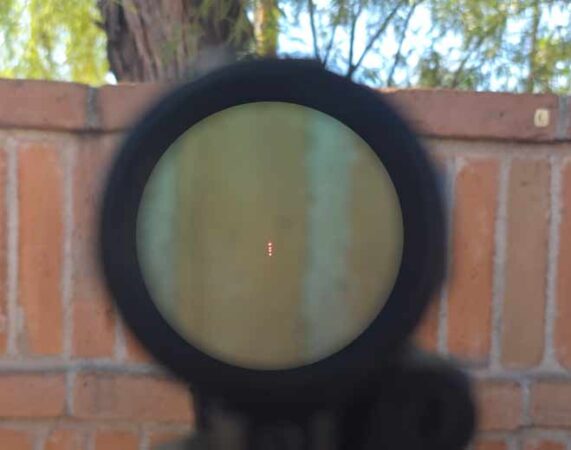
The major downside to a red dot + magnifier has always been the fact that what you want in a red dot is not always what you want in a magnified optic. Red dots are commonly sport larger reticles designed for close-up use and with the brightness set between “pretty” bright and “Eye of Sauron” bright. A magnified optic is the opposite. Ideally, your reticle is smaller and not as bright, so it doesn’t blind you. Use a max brightness green dot and flip down a 6x magnifier, and you might not need LASIK anymore.
SIG’s AMR solves this perfectly. A simple system that requires nothing from the user other than flipping the magnifier into position. With a simple flip, the reticle changes to your preset, so it’s basically perfect when your eye meets it.
While there are a few options, my preferred unmagnified setup was the larger “donut of death”-style reticle at max brightness. For the magnified view, 3 stacked ballistic dots at a lower brightness were perfect and made hits to 400 yards with ease.
Moving between close range and longer range was seamless and easy. Going from targets at 10 yards to targets at 400 yards couldn’t be easier. This results in more hits, faster hits and less fatigue on the shooter.
Basically, it’s the red dot + magnifier perfected.
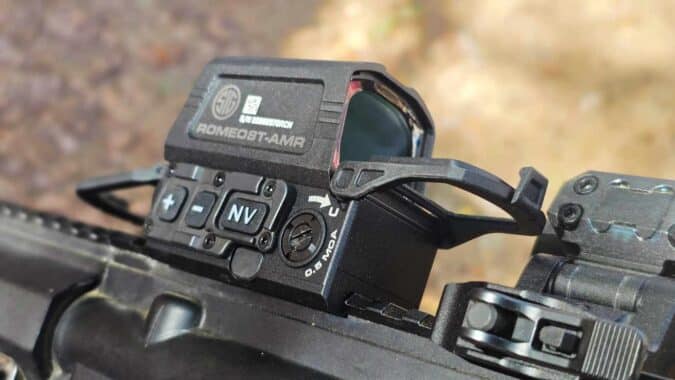
WORTH IT?
The $1,000 MSRP for the Romeo8T-AMR combo kit that comes with a Juliet 3 Micro is not small money, but for what you’re getting, it has more value than at first glance.
Most people aren’t very familiar with the Romeo8T, since most normies looking to spend that much on a red dot only consider Aimpoint or EOTech. But the Romeo8T has seen some solid use among professionals. Sharp-eyed gear nerds have spotted the Romeo8T on American SOF rifles in Africa, AFSOC, CAG and federal law enforcement.
Is it popular because of SIG’s massive reach within the federal government, or because users actually love the optic? I say, “¿Por qué no los dos?”
This version of the Romeo8T has been made even better with a dedicated NV button and lighter than before, though it does drop the sacrificial shroud.
A top-tier red dot combined with a good magnifier, plus the AMR system, assembled in the USA, and a grand starts to feel more reasonable.
Though it would be nice to see the AMR system in something more consumer-friendly, like an upgraded Romeo5.
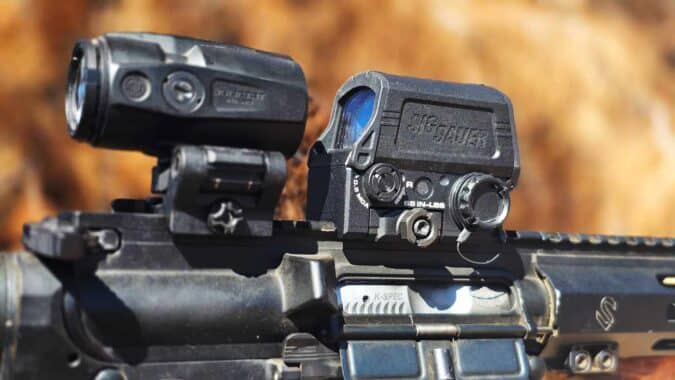
LOOSE ROUNDS
Final thoughts on the Romeo8T-AMR boil down to two, somewhat competing, conclusions. The ability to have two different reticles and brightness settings for magnified and unmagnified is truly awesome and a major improvement to the red dot+magnifier combo. But the AMR system might need a little more maturing to give the features and product options that will appeal to many users.
The Juliet 3 Micro is a good magnifier, but this system would be improved with a long eye relief magnifier and/or different mount options, such as a flip-to-center design.
This first iteration of the AMR is a wonderful proof of concept and an outstanding red dot, but to really take advantage of the AMR design requires a little more from SIG.
Read the full article here

